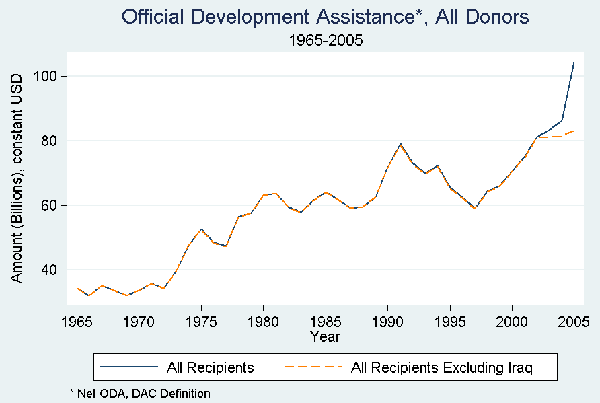Perhaps, but is the amount of money spent going to be less than what we’d spend fighting global warming? (An honest question - I don’t know, and I bet you don’t know either.)
First of all, don’t be so rosy about money magically curing these problems - how much do you think it would cost to build Dutch-style dikes around vulnerable cities in the United States? What would it cost in business if we were hit with a Katrina-magnitude storm every decade instead of every two decades? Where do we get the extra energy if we’re running AC 6 months of the year rather than 4?
At some point, forcing car companies to revise a 22-year-old fuel efficiency standard will be cheap by comparison. Arguably, many of the current proposals for mitigating global warming don’t cost anything at all if you buy into the conservative ideology that a dollar saved by the consumer will be reinvested into the economy and pay for itself - higher fuel efficiency will save consumers gas money, higher lighting efficiency will save consumers electricity money, and driving less or carpooling reduces infrastructure needs.
This belief is likely a function of you trying to jump from step (1) to step (5).
Let’s first talk about your likely misconception - what’s a few degrees, right? We don’t all suddenly die when a warm front comes through. A few degrees change in daily temperature is vastly different from a few degrees change in yearly temperatures. The former means you have a hot day one day. The latter means that you have a hot day every day. When we talk about yearly-averaged, global temperatures, it means every place on Earth has a hot day every day.
For comparison, I have listed the average yearly temperatures of various U.S. cities. Hopefully you will find a pair of cities that are close enough to you so that you can understand what a 1.5-4.5[sup]o[/sup]C change in yearly temperature means.
West Coast:
Seattle 11.6[sup]o[/sup]C (+0[sup]o[/sup]C from Seattle)
San Francisco 13.9[sup]o[/sup]C (+2.3[sup]o[/sup]C)
Los Angeles 17.2[sup]o[/sup]C (+5.6[sup]o[/sup]C)
San Diego 17.9[sup]o[/sup]C (+6.3[sup]o[/sup]C)
Central:
Minneapolis 7.2[sup]o[/sup]C (+0[sup]o[/sup]C from Minneapolis)
Chicago 9.4[sup]o[/sup]C (+2.2[sup]o[/sup]C)
St. Louis 13.4[sup]o[/sup]C (+6.2[sup]o[/sup]C)
Dallas 18.6[sup]o[/sup]C (+11.4[sup]o[/sup]C)
Houston 19.9[sup]o[/sup]C (+12.7[sup]o[/sup]C)
East Coast:
Buffalo 8.7[sup]o[/sup]C (+0[sup]o[/sup]C from Buffalo)
Boston 10.7[sup]o[/sup]C (+2.0[sup]o[/sup]C)
New York 12.6[sup]o[/sup]C (+3.9[sup]o[/sup]C)
Raleigh-Durham 15.2[sup]o[/sup]C (+6.5[sup]o[/sup]C)
Atlanta 16.3[sup]o[/sup]C (+7.6[sup]o[/sup]C)
Miami 24.4[sup]o[/sup]C (+15.7[sup]o[/sup]C)
The lower range of the IPCC 4AR would be like moving from Los Angeles to San Diego, Dallas to Houston, or Boston to New York (probably marginally noticeable). The upper range would be like moving from San Francisco to San Diego, Chicago to St. Louis, or Boston to Raleigh-Durham. If you think any of those can be considered “small” changes, you’ve got bigger problems than I can help you with.
It’s just as wrong to dismiss the potential change as “small” as it is to assume that the potential change is “large”, and there’s plenty of people on both sides of that. This is why scholarship in understanding the risks is a prerequisite for appropriately gauging what mitigation steps to take. If you don’t understand the cost of inaction, you can’t properly judge the cost of action. If you overestimate the cost of inaction (e.g. Gore), you end up with ridiculously expensive proposals which don’t do enough (e.g. Kyoto). If you underestimate the cost of inaction (e.g. Wanniski), you end up costing yourself a pretty penny in the long run (e.g. Stern).
This is why the questions I listed more or less have to be considered in the order I listed them.
 ), and after a cost-benefit analysis believes they’re coming out with a victory; or the team that, at halftime, has no idea what the rules of the game are or what their opponents are doing, yet simply believes that scoring 500 points in the second half will blow away anything their opponents might do?
), and after a cost-benefit analysis believes they’re coming out with a victory; or the team that, at halftime, has no idea what the rules of the game are or what their opponents are doing, yet simply believes that scoring 500 points in the second half will blow away anything their opponents might do?